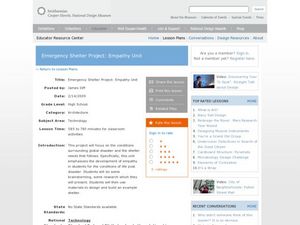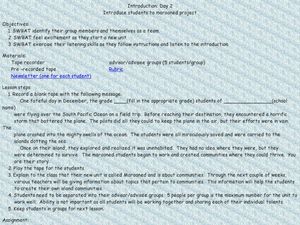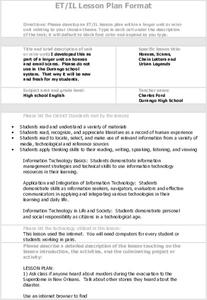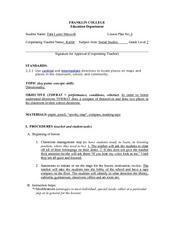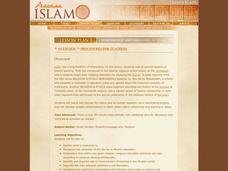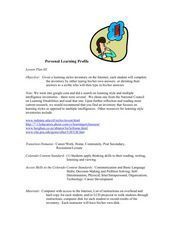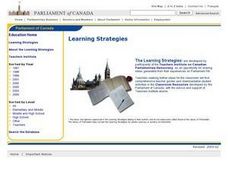Curated OER
How Does Ancestry Affect Folklore?
Students break into groups of 4 or 5 and choose an option to demonstrate a different cultural perspective in a fairy tale or other folklore that they are familiar. Possible choices are: PowerPoint presentation, video, digital...
Curated OER
Small Fish Stick Together
Learners pantomime the book Swimmy. In this philanthropy lesson, students discuss the main character in the text and how Swimmy participated in philanthropic acts. Learners role play the book.
Curated OER
Crossing the Deleware: A Visual Myth or Reality
Students analyze the painting Washington Crossing the Delaware.In this analyzing lesson plan, students analyze this painting that has a lot of historical inaccuracies, and then come up with a persuasive argument supporting or opposing...
Curated OER
Emergency Shelter Project: Empathy Unit
Pupils design emergency shelters. In this designing emergency shelters lesson, students discuss living conditions of people after a natural disaster. Pupils discuss the tsunami that struck East Asia. Students design collapsible...
Curated OER
Introduce Students to the Marooned Project
Students work together to survive on an uninhabited island. In this critical thinking skills lesson, students determine how they will survive and establish communities as they participate in a marooned project.
Curated OER
Family traditions
Second graders discuss family traditions. For this family tradition lesson, 2nd graders identify traditions in their family that have been passed down and bring in 3 things to share that have to do with these traditions. They present...
Curated OER
Hoaxes, Scams, Chain Letters and Urban Legends
Learners explore the evacuation of New Orleans due to Hurricane Katrina. Using the internet, they research stories they may have heard and verify a story's authenticity. Students discuss rumors and urban legends. Given a worksheet,...
Curated OER
World History: Chronology
Students examine periods of time throughout world history. In this time chronology lesson plan, students read and create time lines. Students complete a variety of activities involving the ordering of events in time.
Curated OER
Passport To Parliament
Students examine the Canadian parliamentary system through the investigation of various learning centers that address the issues using a variety of learning preferences.
Curated OER
Responsibility
Learners investigate the importance of accepting responsibility and demonstrating self awareness.
Curated OER
Individual Rights - The Right To Equal Protection
Pupils examine the concepts of equal protection, discrimination, affirmative action, and racial profiling. They analyze the Equal Protection Clause, participate in a mock trial, and discuss the different parts of the trial.
Curated OER
Self-Determination
Learners explore ways to improve self-determination. Using classroom activities, role playing, and small group simulations, students practice and exercise self-determination. They discuss the importance of self-esteem, personal values,...
Curated OER
Oceans
First graders examine how the earth is covered with more water than land. They toss an inflatable globe around the classroom, and each time a student catches the ball with two fingers, they tally whether the fingers land on water or...
Curated OER
Absolute and Relative Location
Second graders understand the difference between relative and absolute location using the grid map as an example of an absolute location. They observe a class map showing longitude and latitude lines and learn that they provide exact...
Curated OER
Directionality
Second graders discuss the cardinal directions and intermediate directions and then look at the spooky map to locate different points on the map. They answer questions about where things are located in reference to another object and...
Curated OER
Famous Virginians
Fourth graders research a famous Virginian. They cite sources of the facts and data which they gather from a variety of sources. They present the material using PowerPoint and an oral presentation.
Curated OER
Scholarship and Learning in Islam
Young scholars explain what a madrasah represents in Islam. Using the Muslim world as an example, they identify and describe two or more centers of learning. They explain the contributions that Muslims have made to science and math and...
Curated OER
What Kind of Smart?
Students participate in a lesson in order to discover the type of intelligence they have for learning. This is done by taking a Multiple Intelligences Survey. The focus of the lesson is a question posed to students. The homework is an...
Curated OER
Learning Style Inventory
Learners investigate their own personal learning style with the use of a personal inventory. They access the inventory by using the internet. Students write reflectively and discuss in class personal style of learning and how they prefer...
Curated OER
Cultural Lit. 40: Native American Self Determination
Students list main event in historical sequence of Self Determination after receiving direct instruction, reading selected texts and working in group structures. They take notes utilizing note-taking frames to list main events in...
Curated OER
Crawford Grill: Opening the Doors of Opportunity
Analyze the role the Crawford Grill played in the history of Jazz music. Budding historians research interviews and video clips to learn about the Crawford Grill in Pennsylvania and black music history. The lesson culminates when...
Curated OER
Hinduism vs. Buddhism
Fourth graders create Venn diagrams showing the differences and similarities between the religions of Hinduism and Buddhism.
Curated OER
It's Debatable!
Students examine the basic elements and vocabulary of debating. They research an issue and write a letter to the editor of the local newspaper, and role-play a Parliamentary debate on a particular bill.
Curated OER
Values Clarification
Students examine their values and what is important to them. They define value, list what is important to them, prioritize the list of values, write a sentence for each value on the list, create a diagram of their number one value, and...





